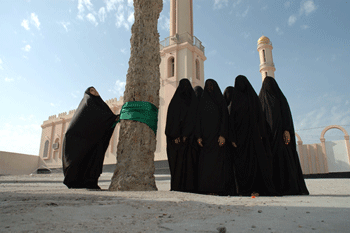
Figure 1: Mosque, women and palm tree.
By el-Sayed el-Aswad
Folk culture provides members of the society with living models in the form of iconic images, key symbols, and root metaphors that enable them to express themselves, and the other as well. Sanctity or religious meaning is bestowed on an object or place for the reason that a religiously significant event (a miracle, wonder or blessing) is associated with it.
At an art exhibition at the College of Art, Bahrain University last year, 2006, I was surprised to see very beautiful and stunning pictures in which a group of women were climbing palm trees (figure 2-5). Recognizing the cultural significance of the palm tree in Arab societies, I decided to interview Waheeda Malullah (figure 6), the artist whose photos show that the climbing of palm trees is not just aimed at the collection of dates commonly consumed in the Arab Gulf countries, but rather at the engagement in spiritual communication with invisible spheres of the cosmos and the achievement of blessing or grace (baraka), among other objectives.
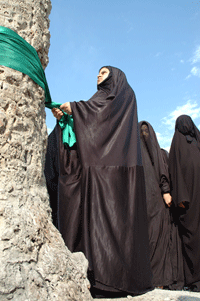 Figure 2: Preparation for climbing.
Figure 2: Preparation for climbing.
Like a mosque’s minaret, a palm tree sets a vertical and ascending dimension in the imagined cosmos (figure 1). The core idea behind these pictures is that to ascend a palm tree is to be close to sacred domains of the universe and initiate dialogue (huwar) with Allah. The dialogue here is an encounter with the divine in its loving, comforting, healing, ascetic, blessed, and bounteous aspect.
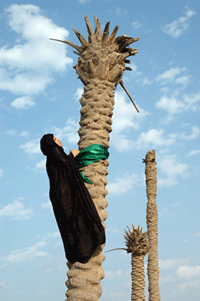 Figure 2: Climbing the palm tree.
Figure 2: Climbing the palm tree.
There are symbolic connotations related to the palm tree in that it stands for fertility in a woman and virility in a man. Though dates strengthen sexual ability and benefit the biological and neurological functions of a man, the palm tree, in the folk imagination, is associated more with women than with men. The palm tree is associated with the green color symbolizing fertility and giving regardless of its size and height or vertical dimension. The long palm tree is said to be proud of her heavily fruit laden stems while the short one is easy to reach. The vernacular description of the palm tree in terms of fertility, beauty, elegance, and production of fruits or dates resembles a fertile woman or bride. In addition, in folk sayings the palm tree is portrayed as a mother. If she falls, one should weep, but if she bends, one can eat her fruits. The palm tree has also been depicted as a father’s sister, (‘amma), or aunt representing kin ties as well as protection and security offered to individuals by the father’s side.
To elaborate the above statements I argue that the palm tree encompasses two domains: one sensory and the other ideational. The sensory dimension of the palm tree is represented in the tree itself as being related to nature. It has ability to adapt to its arid, desert environment. Though its fruits are seasonal, they enjoy high nutritional value, especially in poor and meager milieus such as desert. The fruits, however, differ in shape, size, color, taste, touch and smell. Following the tradition and daily habits of the prophet Muhammad, people aim to eat dates at breakfast on ordinary days and especially in the holy month of Ramadan.
Also, the sensory aspect is related to the artifact and technical applications used in practical and industrial activities of people in their daily life. For instance, during the wedding ceremonies people of Bahrain decorate the entrance of the house with palm reeds not only to indicate this happy occasion, but also to bring blessing (baraka) to the newly wed couples.
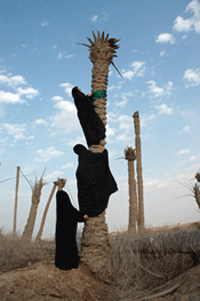 Figure 4: Climbing together.
Figure 4: Climbing together.
The ideational aspect of the palm tree is embodied in the values of fertility, nurturance, bountifulness generosity, and spirituality. It is the value of baraka, blessing, that combines all other values in an integrated pattern. This notion is embodied in Mary, the Virgin, the purest of all women from all nations. The Quran describes the Annunciation as follows:
‘Behold!’ the Angel said, ‘God has chosen you, and purified you, and chosen you above the women of all nations†(Quran, 3: 42). “O Mary, God gives you good news of a word from Him, whose name shall be the Messiah, Jesus son of Mary, honored in this world and the Hereafter, and one of those brought near to God. He shall speak to the people from his cradle and in maturity, and shall be of the righteous.’ She said: ‘O my Lord! How shall I have a son when no man has touched me?’ He said: ‘Even so; God creates what He will. When He decrees a thing, He says to it, “Be!” and it is.’ (Quran, 3: 45-7).
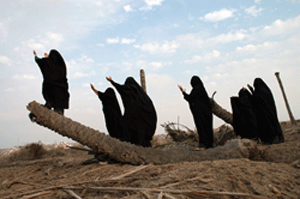 Figure 5: Praying together.
Figure 5: Praying together.
Passions and emotions generate trans-social bonds with certain objects and places. The sacred bond between Mary, the Virgin, and the palm tree is reflected in the miracle of making a barren palm tree give nutritious fruits to Mary while giving birth to Jesus. In the Quran the miracle is mentioned as follows:
“And shake the trunk of the palm tree towards thee: it will drop fresh, ripe dates upon thee. Eat, then, and drink, and let thine eye be gladdened!” (Quran [Maryam] 19:25-26).
The word “trunk†indicates an implicit idea that though the palm tree was barren, the miracle of the production of ripened palm dates occurred. This also explains why the artist shows women performing their cult with fruitless or barren palm trees (figures 1-5). In a word, palm trees here acquire particular meanings of the hidden power of blessings (baraka) that can be achieved through the sacred dialogue or prayer. Other Quranic verses and prophetic tradition or hadiths are quoted and recited to certify the meaning of grace or blessing (baraka) related to palm trees and dates:
“With it He produces for you corn, olives, date palms, grapes and every kind of fruit; verily this is a sign for those who give thoughtâ€. (Quran 16: 11).
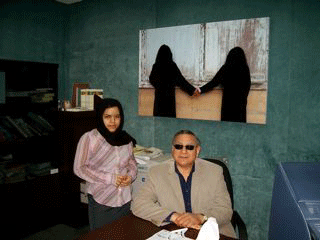
Figure 6: Waheeda with the author.
El Sayed El Aswad, Bahrain University